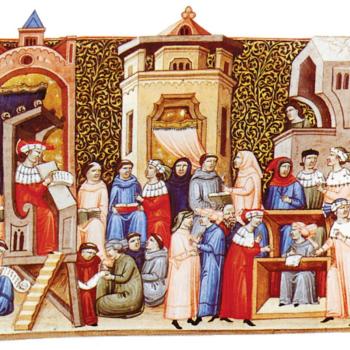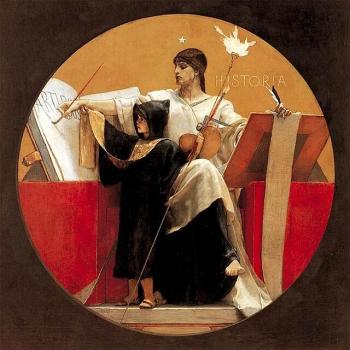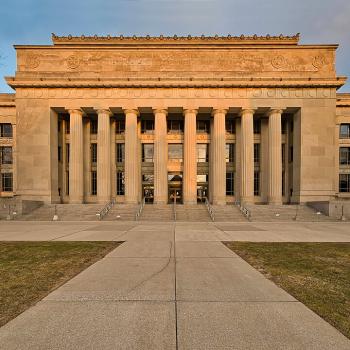I hadn’t planned to pay much attention to this year’s NCAA men’s basketball tournament. In 2019 I won my March Madness bracket for the first time, and I took last year’s pandemic-related cancellation of the tourney as a sign that I should quit while I was on top. But while I didn’t fill out a bracket this year, my dual interests in sports history and Christian higher education made it impossible to ignore some of the unlikely names in this year’s field.
Most of the evangelical educational institutions I study compete at lower levels of collegiate sports, but this year’s Division I bracket includes Grand Canyon and Liberty (whose status as the largest Christian universities in the U.S. has been driven more by online programs than on-campus athletic success), Abilene Christian (which ten years ago was 4-14 in its conference… in Division II), and Oral Roberts University (which hadn’t won a tourney game since the heyday of its namesake but shocked #2 seed Ohio State on Friday afternoon).
They’re not the only religious colleges seeking a title in a sport founded by a YMCA worker influenced by “muscular Christianity.” I’m not sure Syracuse — admittedly far removed from its origins as a Wesleyan seminary — will repeat the 2018 feat of Loyola-Chicago and make the Final Four as a #11 seed. (Syracuse, after all, doesn’t have the support of Sister Jean.) But this year’s top team represents a Jesuit university, Gonzaga. Coached by Mark Few, the son of a Presbyterian pastor, the Bulldogs are led by Jalen Suggs, a freshman point guard who came to Gonzaga via Minnehaha Academy, the Evangelical Covenant school in Minneapolis.
So as my son watched his bracket fall apart yesterday, I spent a little time digging into the history of Christian colleges in March Madness.
Such schools have always been part of the tournament. In 1939, the eight teams in the first NCAA field included a Baptist college from Wake Forest, North Carolina and Philadelphia’s Augustinian College of Villanova. Making the first of its 40 appearances, Villanova lost in the 1939 semifinals to Ohio State; it’s been back to the Final Four five times since, winning it all in 1985, 2016, and 2018. (In his 2017 book, Attitude, Wildcat head coach Jay Wright recounts he and his players washing each other’s feet before their Sweet Sixteen game in the 2016 tournament, inspired by a Holy Thursday homily on John 13 by the team chaplain, Father Rob Hagan.) Creighton and DePaul each made the first of their 22 appearances in the early 1940s; in 1944, the Catholic University of America debuted — then didn’t play the following season because too many players were in the military.
Brigham Young University played its first NCAA tournament in 1950, losing by a point to a Baptist school from Waco, Texas. That summer the BYU squad toured South America, talking about their faith during the day and playing basketball at night — wearing warm-up suits emblazoned with “Mormons” instead of “Cougars.” The following season, BYU played well enough to earn a spot in the National Invitation Tournament (at least as prestigious as the NCAA tourney at the time) and won the championship over the University of Dayton (a Marianist Catholic school). As LDSLiving.com recounts the story, the crowd in Madison Square Garden included LDS church apostle Ezra Taft Benson, who decided that “winning athletic contests could be of ‘incalculable’ value to the Church’s missionary program.” BYU’s mid-century hoops success was part of Mormons moving into the American mainstream, as much as Benson entering Dwight Eisenhower’s cabinet in 1953.
That year the NCAA tournament expanded to 22 teams — half of them religious. In addition to Wake Forest, Baptists were represented by Hardin-Simmons, from the same state as Texas Christian. Oklahoma City University still had close ties with the Methodist Church, which was 15 years away from merging with the Evangelical United Brethren Church, sponsor of Lebanon Valley College — still the smallest school ever to reach the Sweet Sixteen.
To get that far in 1953, the Dutchmen defeated “an overconfident Fordham Rams,” one of six Catholic teams in the field. Along with DePaul and Notre Dame (making the first of a record 36 appearances without reaching the championship game — sorry: Andrea, David, John, and Kristin), that group included four Jesuit institutions: Fordham, Holy Cross, Santa Clara, and Seattle University, whose Chieftains (now Redhawks) had defeated the Harlem Globetrotters in a 1952 exhibition and would lose the 1958 championship game to Kentucky. As he would until 1969, Adolph Rupp coached an all-white roster, while Seattle featured an integrated squad led by future Hall of Famer Elgin Baylor. In the meantime, the Jesuit university in San Francisco had joined Holy Cross (1947) and La Salle (1954) as the first religious schools to win the NCAA tournament. The Dons prevailed in both 1955 (finishing 28-1) and 1956 (29-0), led both times by the great center Bill Russell.
That players like Baylor and Russell starred for Catholic institutions in the 1950s was no accident. Primarily established in urban centers to serve the educational needs of working class immigrants, those universities’ basketball teams actively recruited African American players after World War II, sometimes through their participation on Catholic Youth Organization teams. A decade later, Al McGuire’s eagerness to recruit Black players helped set up Marquette for a remarkable run of tournament success that culminated in the 1977 championship. “He sold kids and families on the fact that: ‘Hey, I’m a white Irish Catholic,’” Fordham professor James Fisher explained, “‘I didn’t grow up in the neighborhood, but I grew up next door to it.’”
What Fisher called the Church’s willingness to turn “demographic fact into theological virtue by embracing urban advocacy and racial justice” is one of the more persuasive explanations for Jesuit basketball success offered in this 2018 New York Times article. That legacy culminated in the 1984 tournament, when Georgetown’s John Thompson became the first Black coach to win the championship. Trying to defend their title in 1985, the Hoyas beat another Catholic university, St. John’s, in the semifinals before losing to an upstart Villanova in a famous upset.
Looking back on that religious and sports history, Jesuit writer James Martin told the Times — maybe half-seriously — that “St. Ignatius of Loyola is praying for all these schools. Even Villanova.”












